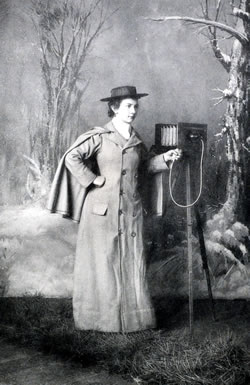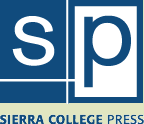Mary Winslow
The end of the 19th century saw the emergence of several pioneering female photographers. Photography was one of the few occupations in which females could participate without the social and professional restrictions that women often encountered. Census documents indicate that 141 women were working in the California photographic industry during this time period, but only a few were employed as independent photographic entrepreneurs. And those who were operating businesses, frequently became itinerant photographers, traveling throughout California and occasionally into the Sierra.
Emma Gills Created Color Images
Emma Gills, a 28-year old widow with two children, survived by taking and enlarging photographs that she hand-colored with India Ink, crayon, and water colors. In July 1876, a Yreka newspaper recalled her recent trip in the Sierra Nevada region, noting: "her trip to Northern California was…to introduce her superior style of pictures, which all who take the pains to examine, and desire a good picture of their friends or selves, will certainly obtain one of her style in preference to the perishable common photographs, which soon fade and look dead."
Floride Green and Lillie Coit
Floride Green was a wandering amateur and commercial photographer for several decades. Her frequent traveling companion was Lillie Hitchcock Coit, who later commissioned the famous Coit Tower in San Francisco. Green’s experiences were uneventful until 1897, when, as a local newspaper reported, "The many friends of Miss Green will regret to learn of her mishap with the flashlight compound called Blitz-Pulver. This ardent lady…was severely burned about the hands by the explosive, but is now well on the way to recovery."
Mary Winslow, Adventurer
But Mary Winslow was certainly the most interesting female photographer in the Sierra Nevada, and perhaps the most intriguing and bravest of all the image makers, male or female. In the 1890s, Winslow traveled alone throughout California taking photographs on commission, while most professional photographers of the era required assistants and, quite frankly, protection. On March 14, 1895, the San Francisco Examiner profiled this groundbreaking and courageous woman:
To be a traveling photographer is a new departure even for the new woman, but that is what Miss Mary Winslow has been for the past three years…. She travels in a buggy alone, and thinks nothing whatever of driving her own horse over any road where somebody’s else’s horse has been driven. She is twenty-five years old, shrewd, self-reliant and not afraid of anything…. When the weather grows warm in the spring she dons a short, plain traveling suit, hitches up her horse and bids farewell to home and friends, to return only when she feels like it.
The Examiner article chronicled the many trips of Mary Winslow throughout the region, including a memorable sojourn to Yosemite: "Her route is never mapped out before she starts…. Acting on this principle she went with a party to Yosemite, where she duly admired the wonderful, had a jolly good time and made photographs at the same time." Mary mostly felt that she was treated "with the utmost deference," although the article did recall that she frequently encountered "the inhospitality of the farming people" in the country and on one occasion was "accosted by a half-dozen drunken hoodlums." Winslow did not travel and photograph simply for adventure, but for clearly stated purpose—"pecuniary pleasure."
Image Credits:
- No photographs of Mary Winslow are known to exist. This image from 1890 likely shows the style of outfit and equipment that Mary Winslow utilized. Source: Portrait of Juvia Johnson from The Photographic Times, June-December 1893, volume XXIII, from the Collections of the University of Nevada, Reno
